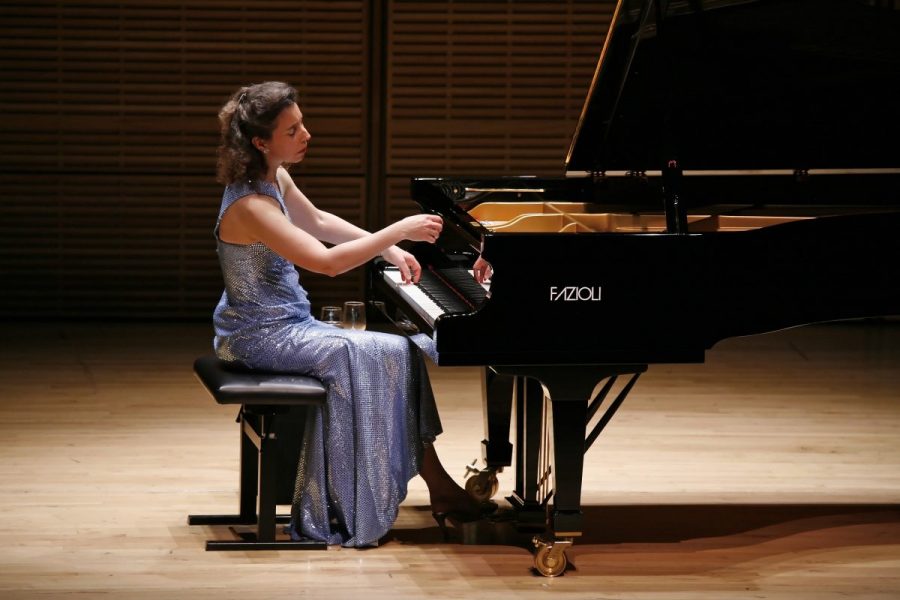@ The Queen’s Hall, Edinburgh, on Thu 13 Aug 2015
The programme brought by renowned pianist Angela Hewitt to this year’s Edinburgh International Festival is alive with insight and balance. It proceeds with that perfect combination: variety interestingly woven through with commonalities. Each half opens with Scarlatti’s baroque crispness (with veiled vestiges of Spanish musical idioms), leading on to composers who are bolder and more open in their folkloric leanings, and finally to pieces that possess a murkier, volatile expressivity. All are seeped in Spanish influence. Guitar figurations and percussive influences permeate, and the careful listener will catch, from this evocative pianism, glimpses of flamenco vocals and castanets.
Hewitt characterises her Scarlatti in a playful, sometimes outwardly dramatic manner. Despite the fluctuating dynamics, she uses a consistency of tone that is in keeping with their originally assigned instrument: there is, alongside the drama, something grounded, matter of fact, and pleasingly solid in her playing of these pithy harpsichord pieces. Few pianists could be more well versed in the art of intricate counterpoint, and when this is called for, the result is like hearing swirling grains of golden sand. Each note is so rounded, so perfectly voiced, so knowing of its size, weight and value in the scheme of things, that the effect is one of a pristine, highly polished order. Nestling in this tight architecture, Hewitt shapes moments of idiosyncratic drama, with the arresting slowing of a phrase or curiously marked contrast.
Once the fleeting, steely horn calls of the Sonata in C major Kk159 have scurried by, Hewitt displays her sublime control of slower, longer contrapuntal lines in the B minor Sonata Kk87, which forms the weighty, meditative kernel in this grouping of Scarlatti. Her fingers truly sing, the lines tugging the phrases through, with particular eloquence in the inner and lower parts. She draws the listener magnetically, for the first time, into a more interior landscape.
Transitioning from the fiendishly difficult and impetuous dexterity (with multiple hand-crossings) of Scarlatti’s D major Sonata Kk29, into the Villanesca from Grandos’s Danzas Españolas Op.37, is a stroke of programmatic genius. Hewitt seems to knowingly enjoy the mischief of this, while proffering a whole new piano sound, awash with warm pastel hues and a sweet-natured, laid-back, naivety. Guitar textures are less subtly redolent here, and the radical change of aesthetic outlook and sensual appeal of this period couldn’t be made clearer, as Hewitt embraces it gloriously.
The two pieces from Granados’s Goyescas Op.11 (although, No.7, El Pelele, is not technically part of the piano set, it is part of the Goyescas opera), are the high point of the first half. Retreating to an even more personal space, Hewitt displays the full range of her colour palette; from sumptuously rich to glittering to opaque and haunting. El Pelele is appropriately wild, with humorous fluctuations in tempo that capture the helpless-comic fate of this rag doll being tossed in a blanket (the image it represents).
Something goes a little amiss at the opening of the concert’s second half, when, with a return to Scarlatti, Hewitt momentarily loses the assuredness of her footing. Soon however, the audience is drawn back under her compelling spell, with the dreamily austere Sonata in G minor Kk8, and her disarmingly delicate interpretation of the Sonata in G major Kk13. Following on, three pieces from Albéniz‘s Suite Espanola Op. 47 are studded with sections of joyful dance and finely expressed ‘vocal improvisations’, with an unnerving demonstration of relaxed control in the percussive sections of No. 5, Asturias. These are taken at a furious tempo, and Hewitt’s hands appear to transform themselves into unerringly precise hammering beaters.
As if she hadn’t yet demonstrated enough stamina, Hewitt concludes with Manuel De Falla‘s Fantasia Baetica, a piece renowned, in its guitar effects (and hence awkward scoring), to eschew pianistic ease. Nobody would know. The performance is fiery and fierce, bursting with intensity and colour, all hewn into a tight, controlled structure. It’s a fitting end to an exhilarating concert, that has pulled open the floodgates of curiosity onto the manifold influences of Spanish folk idioms on standards of the classical canon, and the shape-shifting versatility of both the piano and the pianist’s potential.
